| Victor Frankenstein | |
|---|---|
| Frankenstein; or, The Modern Prometheus character | |
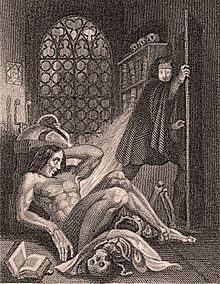 Victor Frankenstein recoiling from his creation | |
| Created by | Mary Shelley |
| Portrayed by | Augustus Phillips Colin Clive Cedric Hardwicke Peter Cushing Ralph Bates Kenneth Branagh Benedict Cumberbatch Sting Jonny Lee Miller Alec Newman Samuel West Aden Young David Anders Harry Treadaway Helen McCrory Raul Julia James McAvoy Tim Curry Hunter Foster Oscar Isaac |
| Voiced by | Charlie Tahan Arthur Darvill |
| In-universe information | |
| Nickname | Dr. Frankenstein, Heinrich "Henry" von Frankenstein (1931 film), Mad scientist, The Modern Prometheus |
| Gender | Male |
| Occupation | Scientist |
| Family | Parents:
Siblings:
Descendants:
|
| Spouse | Elizabeth Lavenza (adoptive sister/wife) |
| Religion | Christian (Roman Catholic) |
| Origin | Naples, Italy |
| Nationality | Swiss |
Victor Frankenstein is a fictional character and the main protagonist and title character in Mary Shelley's 1818 novel, Frankenstein; or, The Modern Prometheus. He is a Swiss scientist (born in Naples, Italy) who, after studying chemical processes and the decay of living things, gains an insight into the creation of life and gives life to his own creature (often referred to as Frankenstein's monster, or often colloquially referred to as simply "Frankenstein"). Victor later regrets meddling with nature through his creation, as he inadvertently endangers his own life and the lives of his family and friends when the creature seeks revenge against him. He is first introduced in the novel when he is seeking to catch the monster near the North Pole and is saved from near death by Robert Walton and his crew.
Some aspects of the character are believed to have been inspired by 17th-century alchemist Johann Konrad Dippel. Certainly, the author and people in her environment were aware of the experiment on electricity and dead tissues by Luigi Galvani and his nephew Antonio Aldini and the work of Alessandro Volta at the University of Pavia.[citation needed]
Percy Shelley, Mary's husband, served as a significant influence for the character. Victor was a pen name of Percy Shelley's, as in the collection of poetry he wrote with his sister Elizabeth, Original Poetry by Victor and Cazire.[1] There is speculation that Percy was one of Mary Shelley's models for Victor Frankenstein; while a student at Eton College, he had "experimented with electricity and magnetism as well as with gunpowder and numerous chemical reactions", and his rooms at the University of Oxford were filled with scientific equipment.[2] Percy Shelley was the first-born son of a wealthy, politically connected country squire, and a descendant of Sir Bysshe Shelley, 1st Baronet of Castle Goring, and Richard Fitzalan, 10th Earl of Arundel.[3] As stated in the novel, Frankenstein's family is one of the most distinguished of the Genevese republic and his ancestors were counselors and syndics. Percy Shelley's sister and Frankenstein's adopted sister were both named Elizabeth. On 22 February 1815, Mary Shelley delivered a baby two months premature; the child died two weeks later.[4] The question of Frankenstein's responsibility to the creature – in some ways like that of a parent to a child – is one of the main themes of the book.
One of the characters of François-Félix Nogaret's novella Le Miroir des événements actuels ou la Belle au plus offrant, published in 1790, is an inventor named "Wak-wik-vauk-an-son-frankésteïn",[5] then abridged as "Frankésteïn", but there is no proof Shelley had read it.[6]
Victor Frankenstein was born in Naples (according to the 1831 edition of Shelley's novel) to a Swiss family.[7] He was the son of Alphonse Frankenstein and Caroline Beaufort, who died of scarlet fever when Victor was 17.[8] He describes his ancestry thus: "I am by birth a Genevese; and my family is one of the most distinguished of that republic. My ancestors had been for many years counsellors and syndics; and my father had filled several public situations with honour and reputation."[9] Frankenstein has two younger brothers – William, the youngest, and Ernest, the middle child.[10] Frankenstein falls in love with Elizabeth Lavenza, who became his adoptive sister (his blood cousin in the 1818 edition) and, eventually, his fiancée.[11]
As a boy, Frankenstein is interested in the works of alchemists such as Cornelius Agrippa, Paracelsus, and Albertus Magnus, and he longs to discover the fabled elixir of life. At the age of fifteen, he loses interest in both these pursuits and in science as a whole after he sees a tree destroyed by a lightning strike and a scientist explains the theory of electricity to him. It seems to him as if nothing can really be known about the world, and he instead devotes himself to studying mathematics, which he describes as "being built upon secure foundations."[12] However, at the University of Ingolstadt in Bavaria, Frankenstein develops a fondness for chemistry,[12] and within two years, his commitment and scientific ability allow him to make discoveries that earn him admiration at the university. He then becomes curious about the nature of life and his studies lead him to a miraculous discovery that enables him to create life in inanimate matter.[13]
Assembling a humanoid creature through corpse assembling and ambiguous means involving electricity, Frankenstein successfully brings it to life, but he is horrified by the creature's ugliness.[14] He flees from his creation, who disappears[14] and, after several negative encounters with the locals, swears revenge on his creator.[15] When his youngest brother, William, is found murdered, Frankenstein knows instantly that his creation is the killer,[10] but says nothing. The Frankensteins' housekeeper, Justine, is blamed for the boy's death and executed; Frankenstein is wracked with guilt but does not come forward with the truth because he thinks no one will believe his story, and he is afraid of the reactions such a story would provoke.[16]
The creature approaches Frankenstein and begs him to create a female companion for him.[17] Frankenstein agrees, but ultimately destroys this creation, fearing the idea of a race of monsters. Enraged, the creature swears revenge; he kills Henry Clerval, Frankenstein's best friend, and promises Frankenstein, "I shall be with you on your wedding night."[18] The creature keeps his promise by strangling Elizabeth on her matrimonial bed. Within a few days, Frankenstein's father dies of grief.[19] With nothing else left to live for, Frankenstein dedicates his life to destroying the creature.[20]
Frankenstein pursues the "fiend" or "Demon" (as he calls his creation) to the Arctic, intending to destroy it. Although he is rescued by a ship attempting an expedition to the North Pole, he dies after relating his tale to the ship's captain, Robert Walton. His creature, upon discovering the death of his creator, is overcome by sorrow and guilt and vows to commit suicide by burning himself alive in "the Northernmost extremity of the globe;" he then disappears, never to be seen or heard from again.[20]
While many subsequent film adaptations (notably the 1931 movie Frankenstein and the Hammer Films series starring Peter Cushing) have portrayed Frankenstein as the prototypical "mad scientist", the novel portrayed him as a tragic figure.
In the book, Frankenstein has many characteristics of a great scientist. At a young age, he has the initiative to study natural philosophy and mathematics.[12] As an adult, he attributes his accomplishments in chemistry to the effort he put into the discipline, rather than his intelligence.[13] Frankenstein also has great curiosity about the world, and even recalls that some of his earliest memories were his realizations about the laws of nature.[12] It is his curiosity about the cause of life that leads him to creating the monster.[13]
Obsession plays a major role in the development of Frankenstein's character. First, as a child, he is obsessed with reading books on alchemy, astrology, and other pseudo-sciences.[12] Later, as a young man, he often spends the entire night working in his laboratory. He then becomes enthralled with the study of life sciences – mainly dealing with death and the reanimation of corpses.[13] Finally, after the monster is created, Frankenstein is consumed with guilt, despair, and regret, leading him to obsess over the nature of his creation and seek revenge.
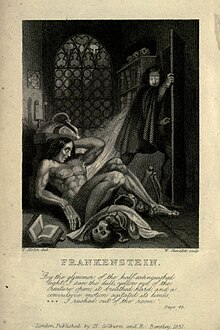

Mary Shelley's novel presents a Promethean theme of defiance of the gods, in reference to the mythological hero. The title of the novel echoes the call of the French materialist philosopher, La Mettrie (1709-1751), in 1747, in his Homme machine, for the advent of a "new Prometheus" who would set in motion a reconstituted human machine.[21][N 1]
The title of the novel echoes the call of the French materialist philosopher, La Mettrie (1709-1751), in 1747, in his Homme machine, for the advent of a "new Prometheus" who would set in motion a reconstituted human machine.[21][N 2]
Mary Shelley did not invent the expression, which had already been used in the early 18th century and, closer to its end, by Immanuel Kant,[22] and Frankenstein goes far beyond the technical substratum, presenting, in addition to its borrowings from myth, metaphysical, aesthetic and ethical aspects.[23]
Frankenstein tells the story of a man seeking to surpass his condition, akin to that of Icarus, the bird-man destroyed by the physical order of the universe.[24] It also evokes the more recent eighteenth-century Faust;[25] Shelley refers to the Faustian idea that knowledge intoxicates the soul and proves dangerous when it becomes excessive, becoming in itself "a serpent's bite".[26] Frankenstein also evokes Pygmalion,[26] king of Cyprus and a sculptor in love with the statue of a woman he has just completed, a new Galatea of flesh and blood after Aphrodite breathes life into her.[27]
The novel also contains hints of Don Juanism: the hero's quest is never satisfied and, like the statue of the commander,[28] the monster appears and precipitates Frankenstein into the bowels of a psychological hell,[29] whose fire is the "bite" of glaciation. Frankenstein also evokes Pygmalion,[26] king of Cyprus and a sculptor in love with the statue of a woman he has just completed, a new Galatea of flesh and blood after Aphrodite breathes life into her.[30] The latter myth was known to Mary Shelley, who had read it first and foremost in the Nouveaux contes moraux et nouvelles historiques, published by Madame de Genlis in 1802,[31][32] then in John Dryden's translation, again published in 1810,[33][N 3] and which she also knew from Rameau's Pigmalion (1748),[N 4] reductions of which for fortepiano were circulating throughout Europe.[34]
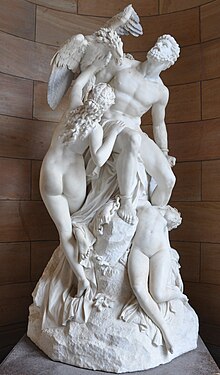
Mary Shelley first refers to the Greek myth of Prometheus, struggling against the omnipotence of Zeus, stealing fire from Olympus and bringing it to mankind to help and save them. In this version of the myth, the rebellious Titan intends to break human destiny by giving them the primary element of energy, and thus of technology, as well as a symbol of Knowledge. He is Prometheus Pyrophoros, the bearer, transporter and provider of fire. This Prometheus, whose name means "Provider", sees beyond the human condition, which he befriends. As a Titan, he enjoys immortality, and his punishment, according to Aeschylus, is to be chained to Mount Caucasus in India and tortured by the eagle, which gnaws away at his liver every day, regenerating it at night. Byron also wrote his Prometheus,[35][36] but the work whose gestation and genesis Mary Shelley was at least able to know,[37] for it was written after Frankenstein between 1818 and 1819, was her lover, then husband, Percy Bysshe Shelley's Prometheus Unbound, a four-act play depicting the Titan, more or less mingled with the Lucifer of Milton's Paradise Lost, a champion of moral and humanitarian virtues, freed from the yoke of Jupiter and heralding the liberation of mankind.[38]
It was likely from Ovid's Prometheus that Mary Shelley drew both the idea of a living humanoid and the method for breathing life into it.[39] What was the work of a Titan became that of a mortal, but one intoxicated by science to the point of believing in his own immortality. Like the Titan, he uses know-how, in this case acquired through study, particularly of the so-called natural sciences, physics and chemistry.[40]
In many ways, however, it is a departure from the Prometheus Unbound, which combines the liberation of the rebellious hero with the downfall of a cruel god, the principle and symbol of evil.[23] The catastrophe takes on cosmic proportions, and the hopes of the modern soul are focused on the advent of a new universe.[41] Shelley's stubborn belief in the ultimate triumph of love and the avenue of the Golden Age[N 5] is fulfilled in the victory over Evil of a hero free of all taint and entirely worthy of representing the Good.[42] Purified by suffering, inhabited by humility and mansuétude, disavowing his ancient pride and hatred, he becomes on his rock a figure of Christ on the cross. His deliverance implies the fall of Jupiter, which is precisely the birth of the Golden Age.[43]
The only thing Shelley's Prometheus Unbound and his wife's Frankenstein have in common, then, is the act of transgression - beneficial in one, evil in the other, responsible in the former, irresponsible in the latter.[43]
Only a few elements in Frankenstein recall this first version of the myth. First of all, the ambition shared by Walton, Frankenstein and even the monster in the central episode of the De Lacey family, to help mankind.[44] Walton hopes to discover a hidden paradise beyond the polar ice caps; Frankenstein claims to conquer death and improve the human race; the monster provides the De Laceys with firewood: here, in grotesque miniature - for while he possesses the Titan's power, he lacks its mighty beauty - is a vignette reproducing exactly the main gesture of the myth, that of providing man with fire.[44] The second element is fire itself, the symbolism of which runs through the novel: the fire-energy of the storm that strikes down the old oak;[45] the fire that is stolen and then lost, giving warmth, light and nourishment; the destructive fire that sets the cottage ablaze; the fire of the pyre or of Hell, or the purifying fire that, as the book promises, will forever consume the monster itself, a morbid emanation of Victor's pseudo-creative imagination. The third point is undoubtedly the allegory of the chained Titan's suffering:[46] such is Victor's mortifying despair, walled in by his silence and pain; such is also the absolute solitude of the monster rejected by his creator and the common man,[N 6] deprived of his feminine complement;[46] such is finally, albeit to a lesser degree, the growing anxiety which, little by little, undermines the youthful and initially conquering enthusiasm of Robert Walton,[47] alienated from his family, his crew and the commerce of men.[48]

Mary Shelley then borrows from the Prometheus of Ovid's Metamorphoses,[49] in which the Titan, rather than coming to man's aid, usurps the power of the gods, then fabricates man and confers on him, through manipulations of "ethereal energy", the most mysterious and sacred of goods - life. He is the Prometheus Pyrophoros et plasticator,[50] i.e. the thief of fire, then the shaper, the craftsman who transforms clay into man. Beyond the original meaning of Ovid's title, for there is more to it than a "change of form" (Meta-morphoses: In noua fert animus mutatas dicere formas / Corpora),[51] this is an act of creation, but with a technique, materials and energy.[52]
It was from Ovid's Prometheus that Mary Shelley drew both the idea of a living humanoid and the method for breathing life into it.[53] What was the work of a Titan became that of a mortal, but one intoxicated by science to the point of believing in his own immortality. Like the Titan, he uses know-how, in this case acquired through study, particularly of the so-called natural sciences, physics and chemistry.[40] Like the Titan too, he is seized (numbed) by a feverish enthusiasm for his decision, the accomplishment of his work, the final technical act conferring the spark of life. The "energy of the ether" was replaced, in a period of scientific discovery, by what Victor's intuition first called "particles of celestial fire", then what his knowledge enabled him to identify as "the galvanizing use of electricity".[54][55] He succeeded in what the scientists of the time hoped one day to achieve, in fact the old foolish dream of the alchemists; the idea, the imagination, the enthusiasm, it was first Cornelius Agrippa[56] and Paracelsus,[57][58] then more rationally, Professor Waldman, no doubt inspired Mary Shelley by Humphry Davy,[59][60] writing in 1816: "science has conferred on him [man] powers that might almost be called creative [...] to interrogate nature [...] in mastery [...], and to penetrate its deepest secrets"; fiction erases Humphry Davy's "almost" and takes the plunge.[40][N 7][61][62] There is thus a very modern dimension to Mary Shelley's use of this Prometheus as metamorphoser, creator, artist-craftsman.[40] Like the Titan, Victor uses clay (the living having returned to dust) and shapes it into a living being. The being had returned to nothingness, and from nothing, he promotes it back to being, in an act that is above all scientific: imagination has joined forces with experimentation, equipping itself with new techniques, the scientist is the new Prometheus, dominating hero, master of the world.[63] In this respect, Frankenstein raises questions that are still relevant today: science can destroy man, but it can also modify, use and manipulate him.[64] The fact that this Prometheus poses the problem of his power implies, de facto, that alongside cognitive awareness, moral awareness must intervene to avoid not only the "ruin of the soul"[N 8] but also that of man himself.[40]

In addition to these two versions of the Prometheus myth, there are borrowings from Milton's Paradise Lost,[65] often mentioned in the Shelleys' diaries,[66] particularly when William Godwin published his work on the poet's nephews,[67] and from Coleridge's poem The Rime of the Ancient Mariner.[52]
Like Milton's Satan,[52] Mary Shelley's modern Prometheus has rebelled against the divine order, that is, against God himself;[31] like Milton's God, Victor abandons his creature;[68] like Satan,[52] Victor and his creature express their loneliness and despair;[69] like Satan too, the monster suffers but does not submit, deciding in the end to choose Evil; like Milton's Adam, finally, he reproaches his creator for having taken him from the earth to make human clay.[N 9][70][71]
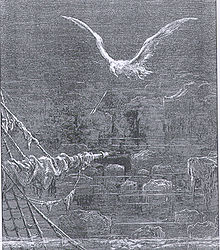
Like Coleridge's sailor, Victor has destroyed the divine order and has remained abandoned by God,[72] solitary, deprived of certainties, on icy continents in the image of the glaciation from which his soul suffers.[73] However, he will not be saved: the exorcism of his story will not save him from physical death, the last avatar of the death of his being that occurred when he gave life to the monster; he would thus have placed his own life in a hideous body,[46] because, since the application of the "instruments of life", he will not cease to decay before perishing altogether.[74] Likewise, and in this respect similar to his creator, also abandoned by his god, the monster finds himself isolated in a universe whose harmony he perceives but cannot share. So he puts his body in unison with his soul and entrusts it to the inaccessible peaks and icy deserts that respond to the coldness of his heart, dragging along his pursuer, who is no longer sure whether he is hunter or game.[74]
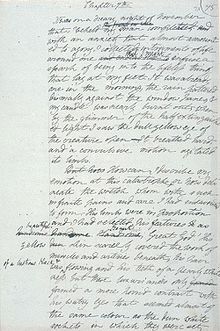
The act of transgression exists, but is never qualified as such. The vocabulary used by Victor, who is not Mary Shelley's spokesman,[46] as he constructs his narrative by restructuring his life and putting it into perspective in the light of what he has retained from it, with its weaknesses, its emotional burdens, its weight of character, is limited to a semantics of research and discovery. Thus, he uses probe into, penetrate, explore, discover, etc. to describe the dynamics of his action, and hidden recesses, deep secrets, unknown territories, further knowledge, etc. to delimit the field of his hard work. Very rarely, a verb like trespass is used to indicate that the work goes beyond any norm.
If there is any judgment on the author's part, it's in the unfolding of the action and Frankenstein's psychological punishment,[47] rather than explicitly expressed by the successive narrator(s).[26] Only the monster is led, like Milton's Adam, to deplore the advent of an undesired life;[26] still, this is an existential misfortune that he endures, rather than an ontological refusal of accession to being.[75]
Transgression consists in the making of a being, then and above all in the act of giving it life.[46]
The creation itself is presented as based on abnormality.[46] The monster's body is a mass of dead flesh and animal flesh. Admittedly, the process responds to a possibility evoked by certain eighteenth-century scientists; however, there is a desacralization of the human being, a corruption of his integrity, a defilement of his purity,[29] all in the light of a Judeo-Christian vision of Man. Mary Shelley does not refer to it explicitly, but the socio-cultural context of the action presupposes its existence as an integral part of the collective consciousness. A dead body can only be resurrected by the One who created it, and animal flesh is not in the image of God. At the beginning of the 19th century, the state of science rejected the possibility on the horizon of the inconceivable; this is therefore an extreme example, a kind of symbol of transgression.[46]
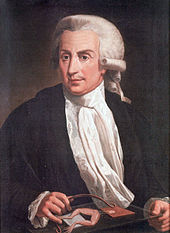
Even when galvanized by electricity, this gift of life seems to run up against a fundamental impossibility, as it's a question of passing from nothingness to being. On the other hand, the monster does not remain in a vegetative state, but proves to be endowed with a cognitive and moral consciousness in every respect equal to that of man.[23] As far as the species is concerned, apart from its aesthetic aspect,[46] it is even superior to man, surpassing him in strength, mobility and agility. Without specifying to whom and to what the right to confer life belongs, Mary Shelley suggests that, in any case, it does not belong to man other than by natural transmission.[76]
Frankenstein, through its title, its overt and covert quotations, its allusions and vocabulary borrowings, refers to the myth of Prometheus, and then to Paradise Lost, one can conclude that the order it presents is above all divine. The act of transgression thus appears as a usurpation of the sacred, the exclusive province of divinity. However, in both cases, the presupposed god is domineering, jealous of his prerogatives, vengeful even, Olympian Zeus (or Jupiter), perhaps the God of the Old Testament.[46] The punishment will be extreme, in the image of the crime or sin: family, moral and physical destruction.[41]
However, the constant reference to the major poetic texts of Mary Shelley's contemporaries and friends - Wordsworth, Coleridge and, of course, Byron and Shelley - and the direct allusions to works such as Tintern Abbey, Childe Harold's Pilgrimage[48] and Mutability, which rest on a substratum of diffuse pantheism, would suggest that the divine order and the natural order merge.[41] One of the functions of nature in Frankenstein is to suggest, if only on a sensory and perceptual level, the presence of transcendence - harmony in the Rhine valley, sovereign grandeur atop the Alpine peaks, infinity and eternity on the icy oceans.[77]

As explained by Edmund Burke in 1757, it is based on astonishment,[78] and to a lesser degree, admiration and reverence, all notions, in fact, by-products of terror (see, according to Burke, the Latin words stupeo or attonitus).[N 10] The ingredients are darkness, power.[79][80]
A few quotations from Burke help to understand this aspect:
"Whatever is fitted in any sort to excite the ideas of pain and danger, that is to say, whatever is in any sort terrible, or is conversant about terrible objects, or operates in a manner analogous to terror, is a source of the sublime"[79][81]
"Whatever […] is terrible, with regard to sight, is sublime too"[82]
"Greatly night adds to our dread […] Almost all the heathen temples were dark […] The druids performed all the ceremonies in the bosom of the darkest woods {…} No person seems better to have understood the secret of heightening, or of setting terrible things, if I may use the expression, in their strongest light by the force of a judicious obscurity than Milton."[83]
"To make any thing very terrible, obscurity seems in general to be necessary."[83]
"I know of nothing sublime which is not some modification of power"[79]
"[…] strength, violence, pain and terror, are ideas that rush in upon the mind together"[79]

Mary Shelley uses the ingredients analyzed or simply listed by Burke to associate Victor Frankenstein's transgression with the notion of the sublime, either to make him describe his states of mind, whether inhabited by torment or exaltation,[84] or to create the illusion that landscapes impose notions of greatness and disquiet, elevation or unease[78] (steep valleys, dark forests, etc.), or simply to arouse a gothic terror (or, in the first part, horror) in the reader. The monster, too, is sublime in its conception (obscurity, isolation), its size (out of the ordinary and frightening), the places it chooses and imposes on Victor (forests, peaks, valleys, abysses, vast deserts, tumultuous or frozen oceans), the unspeakable absoluteness of its solitude, the extremity of its feelings, the unpredictability of its character,[78] its alliance with the elements (storms, glaciers, darkness, earth, water, fire).[84]
For the sublime also lies within human beings. Like a natural landscape, the panorama of the soul arouses astonishment, admiration and respect, or else, by opposition or default, sinks into ridicule (ludicrous, according to Burke).[85] Soon, the inner landscape becomes nocturnal, on the edge of consciousness, a dark, convulsive, spasmodic turmoil; through a play of mirrors reminiscent of the nested, reflective structure, the monster to which Victor has nevertheless given life becomes the very projection of his death wish. The transgression has been placed under the sign of Thanatos: the monster is the negative double of his creator,[86] his evil Doppelgänger[87] who carries out the death sentence unconsciously pronounced by Victor[47] on his family, his friend, his wife, whom he believes he adores but whom he has experienced as castrating, suffocating him with love, protection, moral comfort and social certainties.[41]
The being torn apart by suffering is also a divided being, in turn and at the same time creator and destroyer, provider of life and death, hunter and prey, executioner and victim.[76] The abject monster turns out to be sublime, and the creator thought to be sublime turns out to be abject.[88] This necessarily leads to an escape:[23] the escape of the characters, who find each other only to lose each other, the escape of Victor, then of the monster, the pursuit of one by the other, then of the other by the one, quests as ardent as they are senseless, Walton's, Victor's ("ardour that exceeded moderation"), the monster's ("dream of bliss that cannot be realized"), leading to nothingness.[47] Walton fails to reach the continent of happiness; Victor destroys his loved ones by procuration before destroying himself; the monster immolates himself with the fire that promoted him to being. The quest remains nothing more than a sterile, frozen quest; the fruits have not "kept the promise of the flowers".[N 11][89]
The story is never told by a heterodiegetic narrator. Successive layers of first-person narration are superimposed by the echoes left in the various listeners and the reader.[90] None of the three narrators is Mary Shelley's spokesperson, at least not unreservedly. She entrusts each with words, and therefore character traits, principles, actions, feelings and emotions that she seems to approve of, and others that she rejects.[47] The good and the not-so-good, the evil and the not-so-evil are all mixed up to varying degrees, and the author uses a range of devices, albeit rather limited and rather stereotyped, to let her degree of sympathy, aversion or amused contempt shine through. At times, she approaches the narrators - who are never protagonists in the raw, since all actions belong to the past and are filtered through a network of successive consciousnesses - only to distance herself from them in a constant game of hide-and-seek, swaying to the whim of her irony.[47]
This explains why the author sometimes seems to be moving in the direction of Walton's romantic enthusiasm, or even Frankenstein's, and at other times to be completely detached from it.[47]

All the more so, in fact, as this character's oscillation between euphoria and prostration is pushed to the extreme. Admittedly, this is a kind of stark representation of the romantic hero,[91] but through the repetition of attacks and crises, the portrait of a character that psychiatry would call bipolar gradually emerges, rather unlike his creator. Indeed, as far as we know, and despite the tumultuous effervescence of her household, Mary cultivated the memory of her husband and was concerned with his work, but in a way that erased much of its radicalism, and she always sought to establish a compromise between her fidelity and her condition as a woman, the offspring of a famous family, the widow of a poet of genius, evolving in a non-conformist medium, but a woman all the same in a society reluctant to accept feminist outbursts.[92]
This is how the reader could be taken in by Victor Frankenstein's contradictory statements, and find in them a vacillating ambiguity of Mary Shelley's ethical conceptions.[46] His acts of contrition are easily contrasted, as adisplayed at the beginning of his story, with, for example, the fiery heroic-comic speech he addresses to Walton's sailors, in which he enjoins upon them the firmness of a grand design and the duty of heroism. The exhortation is peppered with ironic nods to William Shakespeare, including the young Henry V's speech to his soldiers, St Crispin's Day,[93] and a disguised quotation from The Tempest in the line "This is not made of such stuff as your hearts may be", parodying the lines "We are such stuff / As dreams are made on, and our little life. Is rounded with a sleep", spoken by Prospero.[94] Then she's framed by bouts of deep despondency (sunk in languor); only Walton, captivated by the character, falls under her spell: "a voice so modulated", "an eye so full of lofty design and heroism".

Mary Shelley's response to Frankenstein's transgression is to be found in the very unfolding of the action. Frankenstein is, among other things, a matter of crime and punishment,[23] the systematic destruction of his family's relational and moral fabric, the disintegration of his being through isolation, guilt, inner torture[52] and, ultimately, the extinction of life.[21] So to claim that the enterprise itself is not reprehensible is a sophism: the tragic personal consequences, the upheaval of institutions, the absurd operation of justice,[48] which condemns on the basis of appearances,[95] are the result of flawed premises. The quest was evil, and the Grail a poisoned chalice.[96]
Insofar as the higher moral instance cannot be identified, since in many ways Frankenstein's world is a world without God,[46] it is appropriate to use the vocabulary of Kant's Critique of Practical Reason, known and appreciated by Coleridge, published in 1787, and simply evoke the presence of a categorical imperative. Here, the moral law exists, but one cannot know its origin, imposing itself rather than imposing it, and certainly not revealing it; it is: in his inspired but irresponsible adolescent dream,[97] Victor has consciously set it aside, and in the process, peace, happiness and life itself have slipped away from him.[76] Nature is fragile, Mary Shelley seems to be saying, and cannot be desecrated with impunity: as Wordsworth wrote at the end of Nutting: "[...] with gentle hand, touch/ For there is a spirit in the wood".[98]
Frankenstein's Promethean dimension covers almost every aspect of the text, whether purely literary, philosophical or moral. The psychological singularity of the characters, especially Victor, exists, but is far from fundamental. Indeed, the very subtitle of the novel immediately places Frankenstein outside human norms. Whatever his affinities with the Romantic hero whose silhouette emerges at the end of the 18th century and finds its plenitude in the first decades of the 19th century, he belongs, in his conception and in the represented projection of this conception, to myth and the imaginary. Nor, like other characters, is he reduced to a single constant, quickly becoming what E. M. Forster has called a round character, full of substance.[47]
His antecedents are legends, doctrines and literary works.[47]
Mary Shelley's prophetic intuition is to be commended, as she inserts herself into a Gothic tradition that is almost on the wane, renewing the genre[99] but, above all, forcing it to pose one of mankind's major problems - that of its own limits.[97] As technology continues to evolve much faster than morality, the duty of the human community, she shows, is to define and set the methods and constraints necessary to ensure that the boundaries of the possible remain unbroken. In fact, Victor's transgression was a crime against humanity and, beyond that, against the Being itself: it was an ontological crime.[100]
The modern reader, like Mary Shelley's contemporary, cannot but endorse the opinion expressed by Percy Bysshe Shelley about his wife's book:
We debate with ourselves in wonder, as we read it, what could have been the series of thoughts -- what could have been the peculiar experiences that awakened them -- which conduced, in the author's mind, to the astonishing combinations of motives and incidents, and the startling catastrophe, which comprise this tale . . . The elementary feelings of a human mind are exposed to view, and those who are accustomed to reason deeply on their origin and tendency will, perhaps, be the only persons who can sympathize, to the full extent, in the interest of the actions which are their result[101]
Besides the original novel, the character also appears or is mentioned in other books from pastiches to parodies.

